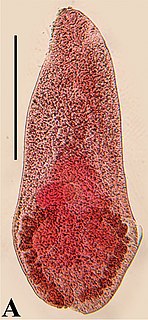Maritrema heardi is a parasitic fluke that infects the marsh rice rat in a salt marsh at Cedar Key, Florida. It was first listed as Maritrema sp. II in 1988, then described as the only species of a new genus, Floridatrema heardi, in 1994, and eventually reassigned in 2003 to Maritrema as Maritrema heardi. Its intermediate host is the fiddler crab Uca pugilator and it lives in the intestine of the marsh rice rat, its definitive host. Together with two other species of Maritrema, it is very common in affected marsh rice rats; it infects 19% of studied rats at Cedar Key. According to Tkach and colleagues, M. heardi is probably primarily a parasite of birds that has secondarily infected the marsh rice rat. Floridatrema was distinguished from Maritrema on the basis of its possession of loops of the uterus that extend forward to the place where the intestine is forked or even to the pharynx. Genetically, M. heardi may be closest to the morphologically similar M. neomi, which infects Neomys water shrews in the Carpathians.
Ascocotyle angrense is a fluke in the genus Ascocotyle that mainly infects birds. It has previously been confused with A. diminuta, which infects fish-eating birds and raccoons. It has also been recorded from the marsh rice rat in a saltwater marsh at Cedar Key, Florida, where it occurred in 25% of animals.
Brachylaima virginianum is a fluke of the genus Brachylaima that infects the Virginia opossum throughout its range. It has also been found in young black bears and in marsh rice rats, both from Florida., and from raccoons in Kentucky.

Catatropis johnstoni is a fluke from the United States. It was first described in 1956 by Martin, who had found cercariae released by the snail Cerithidea californica in southwestern California. When the cercaria were fed into chickens, they developed into mature worms; Martin speculated that the natural host was a waterbird. In 1970, a study of helminths of the marsh rice rat in a saltmarsh at Cedar Key, Florida, found flukes similar to C. johnstoni. The fluke was present in 30% of 110 examined rice rats, with the number of worms per rat varying from 1 to 500. Some Cerithidea scalariformis snails from this marsh also released cercariae similar to C. johnstoni from California. When introduced into chickens, marsh rice rats, Mongolian gerbils, golden hamsters, and house mice, these cercariae developed into infectious flukes. Bush and Kinsella, who reported on the result in 1972, regarded the Florida and California flukes as the same species, as there were only minor size differences between them. Because no marsh-inhabiting rodent occurs in both California and Florida, they agreed with Martin that the normal host of C. johnstoni was most likely a bird, perhaps a rail or shorebird. Nevertheless, the rate of infection in the rice rat is too high for it to be just an accidental host; perhaps C. johnstoni is restricted to saltmarshes but not host-specific.

Echinochasmus schwartzi is a fluke that infects dogs, muskrats, and marsh rice rats. It uses Fundulus fish as its intermediate host. Adults are similar to Echinochasmus microcaudatus, but differ in features of the oral sucker.
Gynaecotyla adunca is a fluke that normally infects birds. It has also been found in 15% of a sample of the marsh rice rat from a salt marsh at Cedar Key, Florida. It uses fiddler crabs such as Uca rapax as its intermediate host.

Microphallus nicolli is a species of digenean parasite in the genus Microphallus. Recorded hosts include the marsh rice rat in a saltmarsh at Cedar Key, Florida, where the crab Eurytium limosum is an intermediate host, and the sea otter in central California. It was previously known as Spelotrema nicolli.
Odhneria odhneri is a digenean parasite in the genus Odhneria of family Microphallidae. It infects several species of shorebirds, including the willet, as well as the marsh rice rat.
Probolocoryphe glandulosa is a digenean parasite in the genus Probolocoryphe of family Microphallidae. Recorded hosts include the clapper rail, ruddy turnstone, raccoon, little blue heron, Wilson's plover, black-bellied plover, and marsh rice rat.
Capillaria gastrica is a parasitic nematode in the genus Capillaria. Among the known host species are the marsh rice rat and deermouse.
Litomosoides scotti is a parasitic nematode in the genus Litomosoides. First described in 1973, it infects the marsh rice rat and is known from a saltwater marsh at Cedar Key, Florida.
Mastophorus muris is a parasitic nematode in the genus Mastophorus. It infects animals such as the marsh rice rat, hispid cotton rat, and singing vole.
Monodontus is a genus of parasitic nematodes in the subfamily Bunostominae of family Ancylostomatidae. Most of its species occur in rodents and suids, but Monodontus louisianensis is from the white-tailed deer and Monodontus giraffae from the giraffe. An unspecified Monodontus has been recorded from the marsh rice rat in Florida.
Parastrongylus schmidti is a species of parasitic nematode in the genus Parastrongylus. It was first described as Angiostrongylus schmidti in 1971 from the marsh rice rat in Florida, but later assigned to Parastrongylus.
Pterygodermatites ondatrae is a species of parasitic nematode in the genus Pterygodermatites. It has been recorded in the hispid cotton rat in Florida and Texas. In Florida, it has also been recorded on the marsh rice rat, together with an unnamed species of the same genus, the female of which cannot be distinguished from that of P. ondatrae.
Physaloptera hispida is a parasitic nematode in the genus Physaloptera. It has been found on the marsh rice rat, hispid cotton rat, Florida mouse, cotton mouse, and oldfield mouse in Florida.
Trichostrongylus affinis is a species of parasitic nematode in the genus Trichostrongylus. It primarily infects cottontails (Sylvilagus), but has also been found in the hispid cotton rat and the marsh rice rat.
Trichostrongylus sigmodontis is a species of parasitic nematode in the genus Trichostrongylus. It primarily infects the hispid cotton rat, but has also been found in the marsh rice rat.


